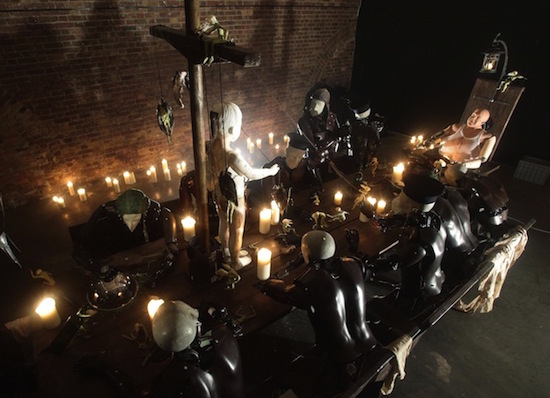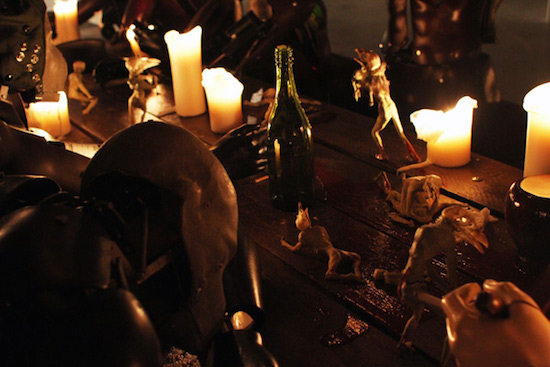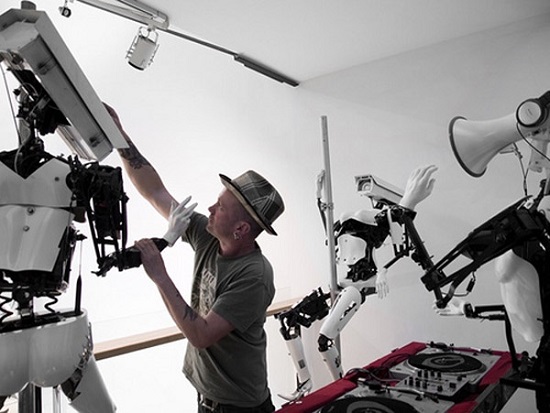The room is windowless, the only light coming from a line of candles on the floor and those burning on the long wooden bench in the centre of the room. Around the table are seated 13 figures, their motion is mechanical: they are having a meal. Music is playing, soft piano that seems too nervous for the solemn scene at the table; occasionally there is a noise like the creaking of a ship. On closer inspection the table is littered with smaller figures, molded gargoyles with bird-skull faces and dolls whose eyes dart quickly from side to side. The figures at the table are skeletal constructions of mask and machine: the re-animated flesh of discarded mannequins. The room inhabits an odd space between nightmare-ish workshop and hallowed church. The figures begin to move, one lifts a cigarette to its mouth which glows as it meets its white plastic lips. Its jaw moves as it begins to speak.
Such is the experience of visiting Giles Walker’s recent exhibition of his animatronic installation The Last Supper at Gallery 223. The work presents a powerful conflation of the sacred and the macabre in its drawing together of the imagery of the biblical last supper with that of condemned inmates on death row (a strange disembodied voice reads out the names of executed prisoners and the contents of their final meals at intervals). Despite the initial awe one feels when faced with the dazzling and quite beautiful robotics on display, in lesser hands its subject could very easily appear crude or mere polemic. Not so with Walker. The work continually creates different moods and effects before dismantling them and examining new ones in a manner which feels wonderfully orchestrated. This sense of orchestration, reflected in the physical sense by the appearance of the marionettes and their exposed strings, gives the whole installation a cohesion that is startlingly affecting and after leaving the room a residue of its presence, like the feeling one often feels after an immersive theatre performance, remains for some time.
For the uninitiated Giles Walker has been making art using robotics and recycled materials for over 20 years. His work often uses the discarded objects which make up his figures to interrogate political subjects, utilising a vast array of materials. In the 1908s and ‘90s Walker was involved with the Mutoid Waste Company who used to organise illegal warehouse parties that blended rave culture with performance art and sculpture, often building huge pieces from broken cars and creating enormous murals in the venues where their parties were held. Since then, his work has taken their aesthetics and materials and developed them into a style all of his own, creating works which politically engage with and critique society by confronting it with the technological remnants it discards on its accelerating trajectory.
What first got you interested in robotics as a medium for your art?
Giles Walker: When I first started with The Mutoid Waste Co. we used to drag in old motors and rip them apart for various pieces we wanted for sculptures. I soon discovered the windscreen wiper motor and then the electric window motors and started making sculptures that moved. At first it was just a good laugh but then I started to notice how much attention they got and how I could use them to manipulate an audience.
Since then cars have developed considerably…and now are ‘robots’ in themselves. The plus side of this is that my sculptures have been able to develop alongside the cars as the scrap available from them became more technical. Now you can find sensors and all the basics you need for a ‘robot’ in the scrap yard. The down side is that there are now too many small black plastic sealed units and you don’t know what they do…
How for you does your solo work relate to your projects with the Mutoid Waste Company?
GW: In the days when we all lived and worked together I think we ingrained ourselves with a way of thinking, and making, a way of living… and a way of looking. I can’t really explain it…but it was to do with a link that existed between our survival and our creative energy as a group. I’ve never lost it and I still see it in most things I do.
I’ve recently started doing a lot of collage. It may seem miles away from the scrap art I used to do…but, for me, it is exactly the same process… except you get to keep your hands cleaner. You have a pile of shit on the floor that you want to turn into something of artistic value.
What drew you to using bird skulls for the heads of many of your figures? In the works in your recent exhibition many seemed to me to be onlookers, observing the work in a similar manner to the viewer. Do you use them as a way of interrogating the people who go to see your work?
GW: The bird figures came about during the building of ‘The Last Supper’. I wanted to portray man in this picture of religion…but I wanted to emphasise the point that the human being is just a species. By sticking bird skulls on human bodies it did this for me. It showed us as creatures. Religion is a man-made curse.
Since then I have used them in loads of my work. I kind of think of them as an ‘everyman’. Sometimes the passive observer, sometimes victim, sometimes perpetrator – but usually adding something to the piece by exposing some characteristic of the human species. I like to show what we’ve evolved into…warts ‘n’ all…and expose the humour in our weaknesses
I wanted to ask you about the presence of death in your work. There seems to be an almost Victorian attitude toward death: a desire for death to be very much present rather than hidden or alluded to. Would you agree?
GW: Not really… I think that my work tends to deal with life. But I admit that the life I portray comes across as a bit dark and futile. That is because I find humour in the darkness and want other people to laugh with me at the way we are.
The pieces I can think of that show death within them tend to be showing how humans have become victims of abstract forces that we have created: religion, finance, etc. These forces have now become out of our control and the majority of the world’s population struggle to live within the constraints they impose on us.
You said before that scrap yards ‘have a beauty like an overgrown graveyard’. How does this presence of death link to your use of scrap materials and the discarded?
GW: Part of the Mutoid mantra was the idea of ‘mutation’. Finding things that had been written off as ‘dead’ and giving them a new life. This could be by simply using scrap in a sculpture or using it for something practical like turning it into a chair,a wood burner, etc.
My ‘robot’ pieces tend to be robots that have been rejected by a society; a society moving so fast that it discards technology almost as quickly as it invents it. The ‘robots’ I build tend to be homeless or prostitutes and drunks trying to survive after they become redundant. This is not how ‘robots’ tend to be portrayed. They tend to be seen as improving our lives, totally efficient, and positive icons of a future to come.
It’s strange because I have recently been given the job of restoring the first ever humanoid robot. Its name is Cygan. Cygan was built in Italy and came to the UK in the ’40’s. There is great BBC footage of it being shown at an exhibition in London. The voice-over talks about how ‘this is the future’ and how they will improve everyone’s lives. Ironically, a few years later no one knew what to do with Cygan and he ended up in ‘girlie show’ in Soho carrying semi naked girls around the stage. So there is a link to the art work I do and how I portray robots.
Does your work always originate from a political standpoint or is the initial impulse always artistic? Is it possible do you think to separate the two?
GW: It depends. At the moment I can’t separate the two. If the initial impulse is artistic then I usually look for a way to politicise it. If I have a political standpoint I wish to explore or express, I look for a way to turn it into a piece of art.
Religion is something which often comes under scrutiny in your art. I wondered what it was that made you return to it so often when, conceptually, the consumerist theme which you also explore appears to have a more obvious connection to the materials you use?
GW: Religion is just such an easy tool to expose human nature for what it is – with all its insecurities, hypocrisy and arrogance. Recently, I’ve tried to stay clear of it because I feared I was getting lazy and always falling back on it for ideas.

I wanted to ask you about ‘The Last Supper’ and wondered if you’d talk a little about why you wanted to draw the link between the famous example from the Bible and the final meal served to inmates on death row before their execution.
GW: The story surrounding The Last Supper is ludicrous. How can Judas be accused of betraying Jesus? Jesus was supposedly the son of God; how can you betray the son of an all seeing, all knowing God? You can’t. Judas was used to fulfil the needs of Jesus and then blamed. He was a patsy.
Anyway, where was I? Oh yeah, the link between the last meal requests on death row and the bible story. There are many, but the first that springs to mind is the irony of so-called Christian countries (the US for example) who find it legitimate to put their criminals to death whilst at the same time preaching “thou shalt not kill”. In some Christian countries they stone people to death for blasphemy. Is this not exactly what happened to Jesus who was deemed a criminal and was put to death by his legislators?
The Last Supper is Jesus’ last meal before being executed. It is the last meal he has, knowing he is to be put to death, and he asks his disciples to eat the bread, his ‘body’, and drink the wine, his ‘blood’. However, how his words are to be interpreted divides Christians into Protestants and Catholics; some believing that the bread and wine become the actual body and blood of Jesus and some holding the view that they are symbolic. Look back over the years and see how many people have been put to death, had last meals, because of the differences of religious opinion – all the Protestants killed by Catholic legislators and vice versa.
One of the things which made ‘The Last Supper’ so powerful for me was that it never came across as a simple act of blasphemy, or merely an overt political metaphor. There was something else, something uncomfortable that made very act of any ‘last supper’ seem like something sacred no matter whose it was. I don’t know if you wanted to talk a little about that.
GW: I never like doing that ‘slogan’ art. It has a very short shelf life and doesn’t interest me that much. I much rather create an art piece that doesn’t give answers but leaves the viewer guessing. I like to evoke a feeling about something rather than give an explanation. Without sounding like a wanker, I like to give something poetry rather than a story. I try and do this with ‘The Last Supper’. The dialogue sounds like it makes sense and that there is a storyline. However, it doesn’t. It’s a kind of interrogation. I wanted to evoke the idea that there was some accusation going on with an underlying threat of violence. But we are left not knowing who is actually being accused or of what.
Many people have seen ‘The Last Supper,’ and although it could be interpreted as something offensive to a ‘believer’, I have never been confronted by anyone claiming that it is. It is dark and, in many ways angry – but I don’t blatantly point the finger at anyone. The piece is also quite beautiful and moving, so it provokes an emotional response but one that is personal and different for everyone. There’s been a few tears shed on occasion.
It’s weird, usually the Christians who see it, interpret the piece to fit their beliefs. They usually think that the child figure standing on the table is Jesus (i.e. the victim). For me, that was Judas! Jesus is the fat bald guy at the end of the table steering ‘the ship’ of course.
I have always found eating meals with people around a table difficult. It is only recently that I actually started enjoying the experience. I would prefer to eat in front of the TV or at least somewhere where there was a distraction. I always found sitting around a table too intense and felt kind of trapped. I’m not sure where it comes from. So, in reply to the question, they may not be ‘sacred’ to me but a meal can have a strange significance to me.
Sound recording is obviously an important element to your robotic pieces and I wanted to ask about the powerful effect of lending human voices to your creations, most notably in Outside the Box.
GW: Getting machines to talk is fun. I love it. I love writing the dialogue, giving the piece its character and playing with the image of what a ‘robot’ is meant to be …or what a piece of art is meant to be.
A ‘robot’ attracts a lot of attention from all people of all ages. Especially if you build it so it can be placed in the public domain. If you want to get an unheard group of people listened to its a very effective way to do it. I did this with a homeless group to get their stories heard and was blown away by the response the robot got. Everyone just tuned in to it and usually stayed until the last story was told.
I am currently working on a project with kids who have been in state care all their lives. I will use the same medium to tell their stories.



